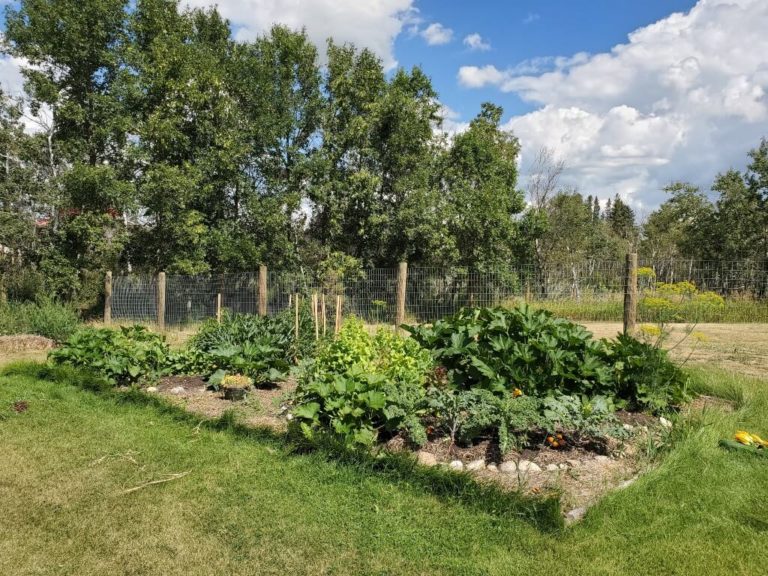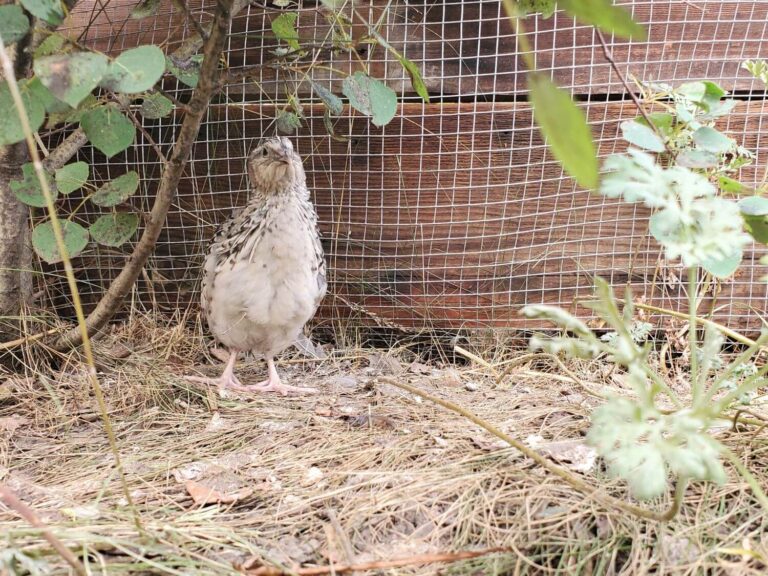AREOGARDEN HARVEST REVIEW: MY HONEST OPINION AFTER 2 MONTHS USING AN AREOGARDEN
This post may include affiliate links. As an Amazon Associate I earn from qualifying purchases. Find more info in my privacy policy.
I’m normally one to advocate for growing food in the most simple, natural, and low-input ways possible, so growing in an AreoGarden is not something I ever really expected to be doing. But, when Mark got me an AreoGarden Harvest for Christmas, I was intrigued by the idea of growing fresh herbs and greens through our long, cold prairie winters.
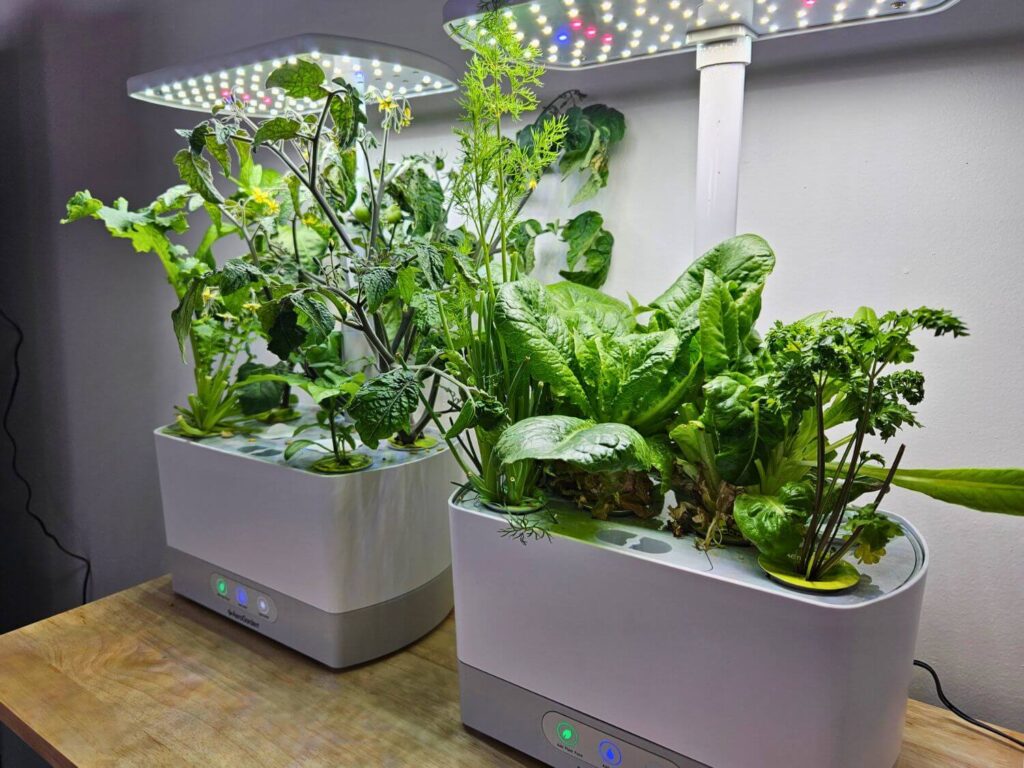
After doing a bit of research and setting up the one I was gifted, I quickly purchased a second unit for a great price during boxing week. It’s now been roughly two months since I began using my AreoGarden and I thought I’d share my thoughts and experiences for those curious about hydroponically growing food indoors.
MY HONEST OPINION AFTER 2 MONTHS USING AN AREOGARDEN
I have to admit that I’ve been pleasantly surprised with the quality, ease of use, and results after using the AreoGarden Harvest for two months. Setup was quick and easy, I had great germination, and, within weeks, I had a steady supply of fresh greens and herbs, which has been so nice in the dead of winter.
My overall review in short answer: if you’ve been considering an AreoGarden, I would definitely recommend trying one out.
For a deeper dive into my experience, more info, and important things to know about AreoGardens, keep on reading.
WHAT IS AN AREOGARDEN?
An AreoGarden is an all-in-one indoor hydroponics growing unit. They come in various sizes and styles but all the gardens include a grow light, water reservoir, and pump system. The lights and pump are automated, so they are very hands-off when it comes to operation. Aside from regularly adding water and plant food, the units are basically set it and forget it.
The gardens come with a seed kit and a bottle of liquid plant food so you have everything you need to get started right out of the box. AreoGarden makes seed kits with herbs, greens, vegetables, and flowers. You can also purchase grow-anything seed pod kits which supply the pods, stickers, and growing sponge, but no seeds. These allow you to use your own seed to grow the plants and varieties you want.
The model of AreoGarden you choose will depend on the number and type of plants you’d like to grow. The units range from 3- to 24-pod capacity and vary in the maximum grow light height from 10” to 36”.
| MODEL NAME | POD CAPACITY | MAX GROW HEIGHT | |
| Sprout | 3 | 10″ | Check Price |
| Harvest (base model, XL, Slim, 2.0, 360, Elite) | 6 | 12″ (XL is up to 18″) | Check Price |
| Bounty (base model, Basic, Elite) | 9 | 24″ | Check Price |
| Farm (base model, XL, Plus) | 12 or 24 | 12-36″ depending on sub-model | Check Price |
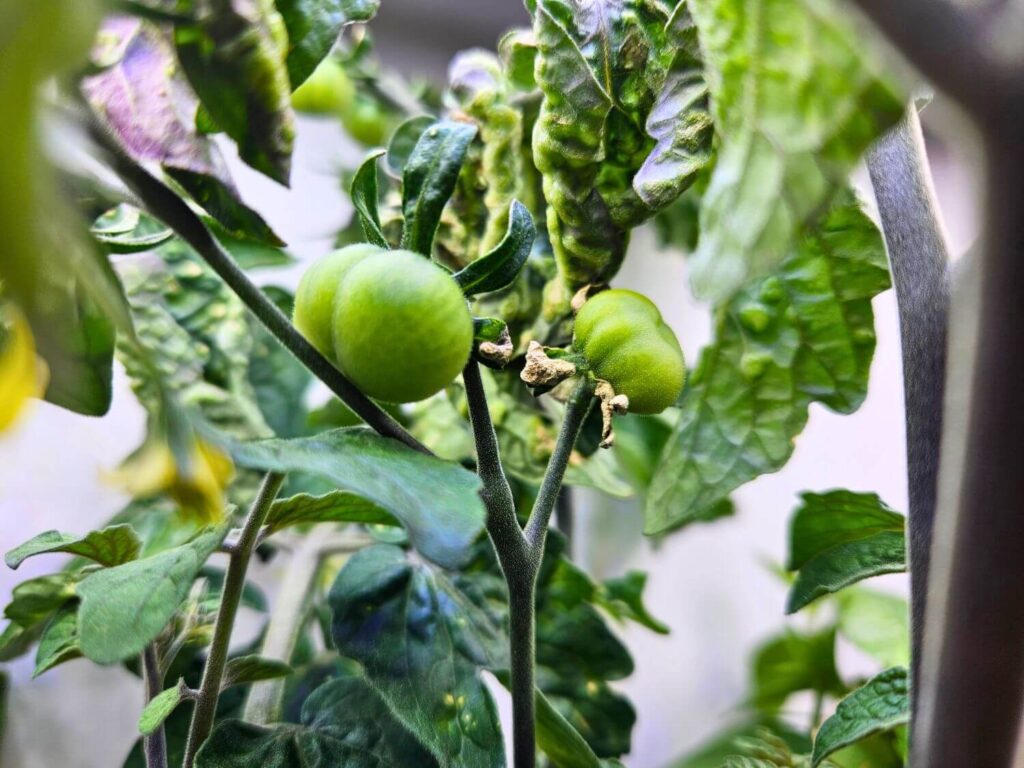
WHAT CAN YOU GROW IN AN AREOGARDEN?
Plants best suited for hydroponic growing include:
- Herbs such as basil, thyme, dill, parsley, cilantro, mint, oregano, chives, and more
- Greens such as lettuce, kale, bok choy, arugula, chard, collards, and more
- Veggies such as peppers, tomatoes, eggplant, and cucumbers
- Various flowers
What you’re able to grow will depend on the size of the garden you have. The smaller models such as the Sprout and the Harvest are better suited to greens, herbs, and micro versions of tomatoes and peppers. The larger units like the Bounty and the Farm allow for higher vertical growth and can accommodate larger plants.
It’s important to note that growing larger plants will limit the number of pod spaces you can effectively utilize at a time. If you fill every pod space, your AreoGarden can quickly become an overgrown jungle. Leaving some spaces empty will give the plants more room and make harvesting, pruning, and managing your garden easier. Keep this in mind when choosing the size of AreoGarden. If you’re wanting to grow larger veggies or a lot of different varieties, you’ll want to oversize the unit you choose.
MY PERSONAL EXPERIENCE WITH THE AREOGARDEN HARVEST
As I mentioned, I was gifted an AreoGarden Harvest for Christmas. This is the base model in the Harvest line with a 6-pod capacity and a maximum grow light height of 12”. After doing a bit of research and realizing I was likely going to want to experiment with more than what a 6-pod unit could accommodate, I quickly snapped up a second Harvest on a great sale.
I found the setup and operation of the AreoGarden to be very straight forward. The growing sponge and seeds are placed inside a plastic seed pod basket, which then goes into the hole in the top tray of the garden. The reservoir is filled with water and this is also where a small amount of liquid plant food is added. Once plugged in, the LED grow light and circulation pump run on an automated cycle. Indicator lights let you know when it’s time to add more water and fertilizer. The height of the LED grow light is adjustable as the plants grow taller.
In the first unit, I used the pre-seeded AreoGarden pods and started two types of lettuce, parsley, Thai basil, dill, and thyme. Everything except the thyme germinated very quickly and within 2-3 weeks, I was starting to prune and harvest small amounts of basil, lettuce, and dill. AreoGarden claims that germination and growth is 5 times faster in their systems than in soil. I didn’t do any side-by-side testing of this, but I was pleasantly surprised by how quickly things were up.
Since those initial harvests, I have consistently been harvesting lettuce and herbs every 4-6 days, or so. I have found that I have to stay on top of pruning and harvesting to keep things from getting crowded out. Which is fine. Since the whole point is to have a steady supply of fresh greens and herbs, I don’t mind having to clean up the garden on a regular basis. This has been supplying the two of us with lettuce for sandwiches and the occasional side salad and enough fresh herbs to use for cooking and making dips and sauces. None of the harvests provide an excessive amount of any one thing. It’s just a nice steady supply of fresh greens and herbs.
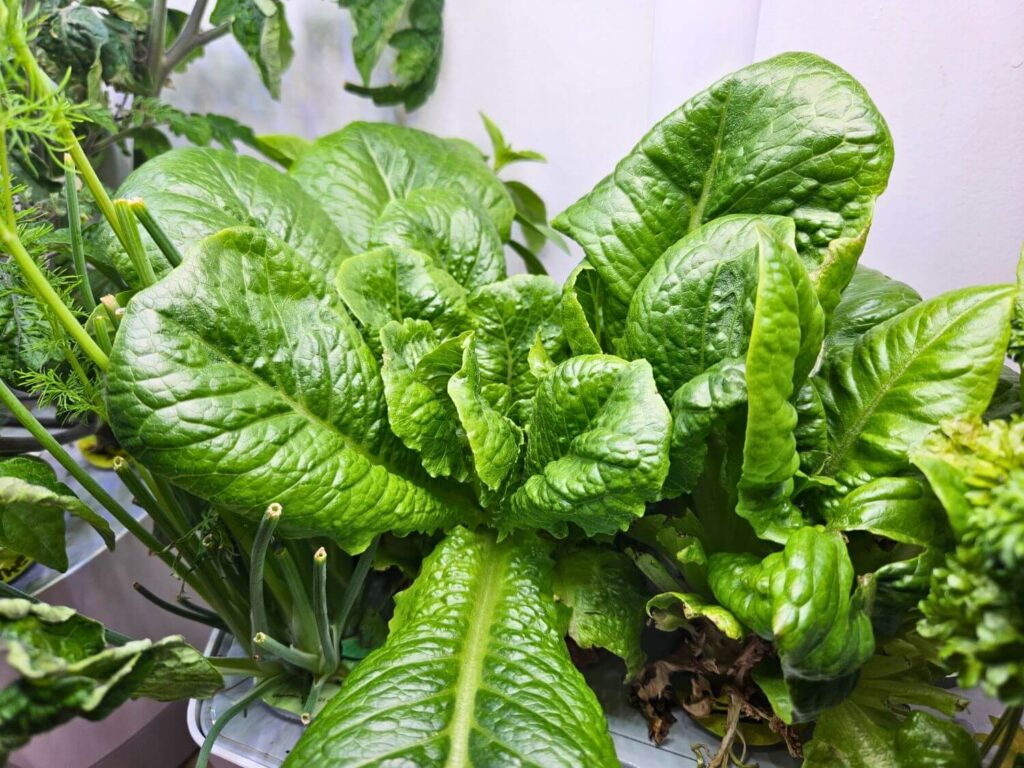
I held off on planting the second unit until I had received some seeds I ordered to experiment with. About a month ago, I planted dwarf versions of kale, tomatoes, jalapenos, and a bell pepper. Since these plants will be larger, I only put four pods in the 6-pod unit. Currently, I have already harvested a handful of kale leaves multiple times. The tomato plant is flowering and there are lots of small green tomatoes starting to form. The jalapeno plant is right on the verge of flowering. The bell pepper is a bit further behind and still small but looks healthy. With the other plants being so much larger, the smaller pepper plant may very well be too shaded and not getting enough light. I have pruned the other plants some to open up the canopy a bit and let more light through.
As far as operation of the AreoGardens, I’ve appreciated the indicator lights which let me know when to add more plant food and water without me having to track anything. The fertilizer is added every two weeks and is measured by capfuls based on the size of the unit. It makes it very easy and foolproof. I’ve found since the plants have grown larger, I need to top up the water every 2-4 days or so. Especially the garden with the vegetables. Those plants use up water much faster than the herbs and lettuce. It is recommended to empty and clean the reservoir every 4-6 weeks or so. I have not done this yet and the reservoirs look good with no visible algae growth. I have used pod covers in the empty holes to keep light from entering the reservoir, which are supposed to help reduce algae growth.
I’m looking forward to seeing how long I’m able to harvest of the exiting plants and seeing how much I’m able to produce from the tomatoes and peppers. In the meantime, I’ll continue to enjoy checking the plants each day to see how they’ve grown (it’s amazing the change that can happen in just one day!) and harvesting fresh food right at home, even in the dead of winter.
I’ve also purchased the seed starting kits for the gardens, which allow for starting plants for transplanting into the garden. The seed starting tray has 24 pod spaces and the kit came with plant food and grow sponges. I’m excited to try out a new method of seed starting this spring and will provide an update on how that goes.
Overall, I’ve been very happy with my AeroGarden Harvests and would recommend them to anyone looking to try out hydroponics. As far as set up, operation, and results go, I’m impressed. In my opinion, the downsides to AreoGardens relate more to the big picture considerations that would apply to any garden of this type – the use of peat, plastic, and energy that come with a commercialized way of growing food. If that doesn’t align with your lifestyle or philosophy, then these may not be for you.
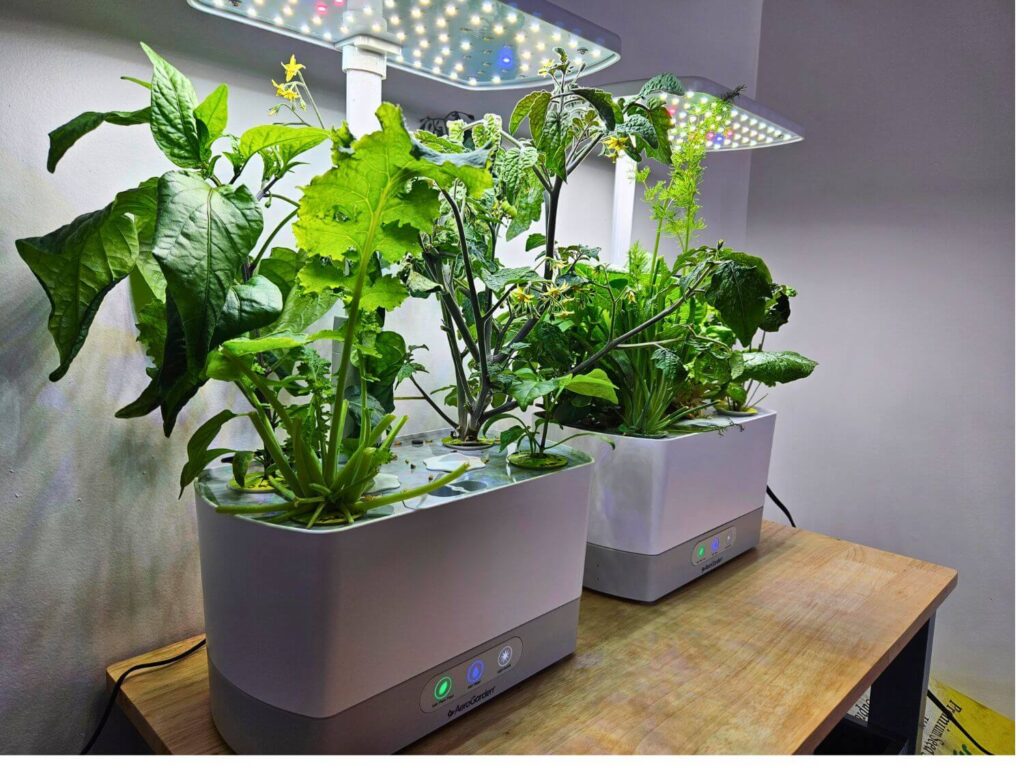
PROS OF USING AN AREOGARDEN:
- Easy to set up and use.
- The grow lights are on an automatic timer so there’s no need to track hours and turn anything on or off.
- Indicator lights make watering and fertilizing foolproof.
- Since they produce their own light, they can be set up almost anywhere – even a dark corner of the basement.
- I’ve found germination and growth of plants to be fast and reliable.
- Having the option to purchase various pre-made seed kits or empty pods and sponges that allow you to grow your own seed is nice.
- The optional seed starting kits expand the functionality of the unit and allow you to start transplants for your garden.
- Having fresh herbs, greens, and vegetables in the middle of winter without having to go to the grocery store for sub-par produce is pretty amazing.
CONS OF USING AN AREOGARDEN:
Cost. The units themselves are pricey, plus there’s the ongoing cost of buying replacement seed pods. Of course, you can re-use the pod baskets and use your own seed to cut down on costs. And, with the increasing price of food, you’ll likely save in the long run by being able to grow your own. But those initial startup costs are a little hard to swallow.
Energy use. The LED lights use a minimal amount of energy (energy usage of the various units can be found here) but they do still require a power source to function.
Plant spacing. The garden becomes quite overcrowded and jungle-like if you fill all the available pod spaces. Regular harvesting and pruning are necessary. In some cases, you won’t be able to use all the spaces if you’re growing larger plants like peppers and tomatoes. If you want a wide variety of plants at once, you’ll have to oversize the unit you choose.
Use of peat. The AreoGarden brand grow sponges use peat. You can get off-brand coco coir-based replacement sponges, but the AreoGarden units come with seed kits that include the peat sponges. Not great if you’re against using peat for ethical reasons.
Use of plastic. The seed pod baskets can be washed and re-used but if you don’t like the idea of using plastic in food growing, this is likely not the best option for you.
End-of-life considerations. The units seem well-made and durable but, inevitably, they will reach the end of their life cycle and will leave a lot of plastic and electrical components that need to be disposed of. The LED lights are not individually replaceable and the entire light hood needs to be replaced when the diodes start to fail. The life expectancy of the diodes is 2-4 years.
I hope you found my AeroGarden Harvest review helpful! I plan to share more updates over time as I experiment with different things and gain more experience with my gardens.

